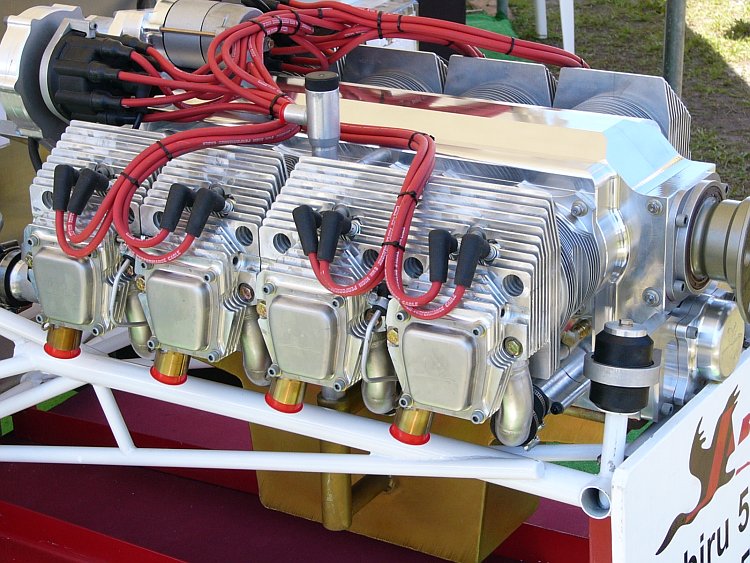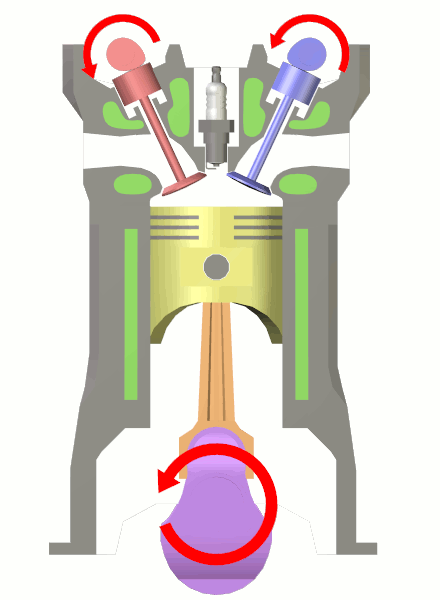|
Flathead Engine
A flathead engine, also known as a sidevalve engine''American Rodder'', 6/94, pp.45 & 93. or valve-in-block engine, is an internal combustion engine with its poppet valves contained within the engine block, instead of in the cylinder head, as in an overhead valve engine. Flatheads were widely used internationally by automobile manufacturers from the late 1890s until the mid-1960s but were replaced by more efficient overhead valve and overhead camshaft engines. They are currently experiencing a revival in low-revving aero-engines such as the D-Motor. The side-valve design The valve gear comprises a camshaft sited low in the cylinder block which operates the poppet valves via tappets and short pushrods (or sometimes with no pushrods at all). The flathead system obviates the need for further valvetrain components such as lengthy pushrods, rocker arms, overhead valves or overhead camshafts. The sidevalves are typically adjacent, sited on one side of the cylinder(s), though ... [...More Info...] [...Related Items...] OR: [Wikipedia] [Google] [Baidu] |
|
 |
Luxury Car
A luxury car is a passenger automobile providing superior comfort levels, features, and equipment. More expensive materials and surface finishes are used, and buyers expect a correspondingly high quality (business), build quality. The term is relative and unavoidably subjective, reflecting both objective qualities of a car and projected and perceived brand image, image of the vehicle's brand, marque. Luxury brands rank above ''premium brands'', though there is no clear distinction between the two. Luxury cars span from sports cars to large Saloon (car), saloons and sport utility vehicles. "Compact car, Compact" luxury vehicles also fill a niche. Classification standards Several car classification schemes include a luxury category, such as: * Australia: Since the year 2000, the Federal Government's luxury car tax applies to new vehicles over a certain purchase price, with higher thresholds applying for cars considered as fuel efficient. As of 2019, the thresholds were appr ... [...More Info...] [...Related Items...] OR: [Wikipedia] [Google] [Baidu] |
 |
Dual Ignition
Dual Ignition is a system for spark-ignition engines, whereby critical ignition components, such as spark plugs and magnetos, are duplicated. Dual ignition is most commonly employed on aero engines,Crane, Dale: ''Dictionary of Aeronautical Terms, third edition'', page 177. Aviation Supplies & Academics, 1997. Aviation Publishers Co. Limited, ''From the Ground Up'', (27th revised edition), page 67, and is sometimes found on cars and motorcycles. Dual ignition provides two advantages: redundancy in the event of in-flight failure of one ignition system; and more efficient burning of the fuel-air mixture within the combustion chamber. In aircraft and gasoline-powered fire fighting equipment, redundancy is the prime consideration, but in other vehicles the main targets are efficient combustion and meeting emission law requirements. Efficiency A dual ignition system will typically provide that each cylinder has twin spark plugs, and that the engine will have at least two ignition c ... [...More Info...] [...Related Items...] OR: [Wikipedia] [Google] [Baidu] |
|
Engine Knocking
In spark-ignition internal combustion engines, knocking (also knock, detonation, spark knock, pinging or pinking) occurs when combustion of some of the air/fuel mixture in the cylinder does not result from propagation of the flame front ignited by the spark plug, but when one or more pockets of air/fuel mixture explode outside the envelope of the normal combustion front. The fuel–air charge is meant to be ignited by the spark plug only, and at a precise point in the piston's stroke. Knock occurs when the peak of the combustion process no longer occurs at the optimum moment for the four-stroke cycle. The shock wave creates the characteristic metallic "pinging" sound, and cylinder pressure increases dramatically. Effects of engine knocking range from inconsequential to completely destructive. Knocking should not be confused with pre-ignition—they are two separate events. However, pre-ignition can be followed by knocking. The phenomenon of detonation was described in Novem ... [...More Info...] [...Related Items...] OR: [Wikipedia] [Google] [Baidu] |
|
 |
Top Dead Centre
In a reciprocating engine, the dead centre is the position of a piston in which it is either furthest from, or nearest to, the crankshaft. The former is known as top dead centre (TDC) while the latter is known as bottom dead centre (BDC). More generally, the dead centre is any position of a crank where the applied force is straight along its axis, meaning no turning force can be applied. Many sorts of machines are crank driven, including unicycles, bicycles, tricycles, various types of machine presses, gasoline engines, diesel engines, steam locomotives, and other steam engines. Crank-driven machines rely on the energy stored in a flywheel to overcome the dead centre, or are designed, in the case of multi-cylinder engines, so that dead centres can never exist on all cranks at the same time. A steam locomotive is an example of the latter, the connecting rods being arranged such that the dead centre for each cylinder occurs out of phase with the other one (or more) cylinders ... [...More Info...] [...Related Items...] OR: [Wikipedia] [Google] [Baidu] |
|
Overhead Valve Engine
An overhead valve engine, abbreviated (OHV) and sometimes called a pushrod engine, is a piston engine whose valves are located in the cylinder head above the combustion chamber. This contrasts with flathead (or "sidevalve") engines, where the valves were located below the combustion chamber in the engine block. Although an overhead camshaft (OHC) engine also has overhead valves, the common usage of the term "overhead valve engine" is limited to engines where the camshaft is located in the engine block. In these traditional OHV engines, the motion of the camshaft is transferred using pushrods (hence the term "pushrod engine") and rocker arms to operate the valves at the top of the engine. However, some designs have the camshaft in the cylinder head but still sit below or alongside the valves (the Ford CVH and Opel CIH are good examples), so they can essentially be considered overhead valve designs. Some early intake-over-exhaust engines used a hybrid design combining eleme ... [...More Info...] [...Related Items...] OR: [Wikipedia] [Google] [Baidu] |
|
 |
Aircraft
An aircraft ( aircraft) is a vehicle that is able to flight, fly by gaining support from the Atmosphere of Earth, air. It counters the force of gravity by using either Buoyancy, static lift or the Lift (force), dynamic lift of an airfoil, or, in a few cases, direct Powered lift, downward thrust from its engines. Common examples of aircraft include airplanes, rotorcraft (including helicopters), airships (including blimps), Glider (aircraft), gliders, Powered paragliding, paramotors, and hot air balloons. Part 1 (Definitions and Abbreviations) of Subchapter A of Chapter I of Title 14 of the U. S. Code of Federal Regulations states that aircraft "means a device that is used or intended to be used for flight in the air." The human activity that surrounds aircraft is called ''aviation''. The science of aviation, including designing and building aircraft, is called ''aeronautics.'' Aircrew, Crewed aircraft are flown by an onboard Aircraft pilot, pilot, whereas unmanned aerial vehicles ... [...More Info...] [...Related Items...] OR: [Wikipedia] [Google] [Baidu] |
 |
Single-cylinder T-head Engine (Autocar Handbook, 13th Ed, 1935)
A single-cylinder engine, sometimes called a thumper, is a reciprocating engine, piston engine with one Cylinder (engine), cylinder. This engine is often used for motorcycles, scooter (motorcycle), motor scooters, motorized bicycles, go-karts, all-terrain vehicles, radio control, radio-controlled vehicles, power tools and garden machinery (such as chainsaws, lawn mowers, cultivators, and string trimmers). Single-cylinder engines are made both as 4-strokes and 2-strokes. Characteristics Compared with multi-cylinder engines, single-cylinder engines are usually simpler and compact. Due to the greater potential for airflow around all sides of the cylinder, Air-cooled engine, air cooling is often more effective for single cylinder engines than multi-cylinder engines. This reduces the weight and complexity of air-cooled single-cylinder engines, compared with liquid-cooled engines. Drawbacks of single-cylinder engines include a more pulsating power delivery through each cycle and highe ... [...More Info...] [...Related Items...] OR: [Wikipedia] [Google] [Baidu] |
 |
Sports Car
A sports car is a type of automobile that is designed with an emphasis on dynamic performance, such as Automobile handling, handling, acceleration, top speed, the thrill of driving, and Auto racing, racing capability. Sports cars originated in Europe in the early 1910s and are currently produced by many manufacturers around the world. Definition Definitions of sports cars often relate to how the car design is optimised for dynamic performance, without any specific minimum requirements; both a Triumph Spitfire and Ferrari 488 Pista can be considered sports cars, despite vastly different levels of performance. Broader definitions of sports cars include cars "in which performance takes precedence over carrying capacity", or that emphasise the "thrill of driving" or are marketed "using the excitement of speed and the glamour of the (race)track" However, other people have more specific definitions, such as "must be a two-seater or a 2+2 seater" or a car with two seats only. In the ... [...More Info...] [...Related Items...] OR: [Wikipedia] [Google] [Baidu] |
|
T-head Engine
A T-head engine is an early type of internal combustion engine that became obsolete after World War I. It is a sidevalve engine distinguished from the more common L-head by its valve placement. In T-head engines, the intake valves are located on one side of the engine block and the exhaust valves on the other. When viewed from the end of the crankshaft, especially in a cutaway view, the cylinder and combustion chamber resemble a 'T', leading to the name "T-head". In contrast, an L-head engine has all valves on the same side. Overview The T-head engine was an early form of crossflow cylinder head. It was relatively complex for its time, requiring separate camshafts for the intake and exhaust valves. T-heads were typically intricate castings, necessitating blind bores for the cylinders and valve chambers. This complexity made T-head engines more expensive to produce compared to the simpler L-head (flathead) engines. Moreover, T-head engines were heavy and inefficient for their di ... [...More Info...] [...Related Items...] OR: [Wikipedia] [Google] [Baidu] |